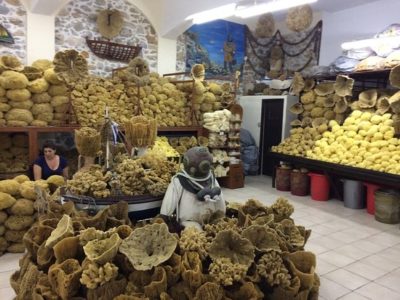Kalymnos natural sea sponges
Diving for sea sponges brought social and economical development to the island of Kalymnos where the free-diving method was used. Kalymnos was the main center of production in the Aegean, and still now is a traditional occupation with related exhibitions, along with other local folklore, at three local museums.
The crew went out into the Mediterranean Sea in a small boat, and used a cylindrical object with a glass bottom to search the ocean floor for sponges. When one was found, a diver went overboard to get it. Free diving, he was usually naked and carried a 15 kilograms (33 lb) skandalopetra, a rounded stone tied on a rope to the boat, to take him down to the bottom quickly. The diver then cut the sponge loose from the bottom and put a special net around it. Depth and bottom time depended on the diver’s lung capacity.
Sea sponges
Sponges are aquatic animals, living mostly in the marine environment. They have neither brain nor central nervous system and maintain plant like qualities. Although only 7 types of sponges are currently commercially traded, there are at least 5.000 types of Natural Sponges known to man.
Natural sea sponges are of greater value over synthetic sponges for many reasons. Sea sponges are more durable and last longer than synthetic sponges because they are more resistant to abrasion. They are better for bathing and cleaning because they soak up and hold more water without dripping and at the same time, they are self-cleaning through their intricate system of canals.
Natural sea sponges actually have enzymes in them that inhibit the growth of mold, mildew, and bacteria. Yet, they are toxin-free and hypo-allergenic. With the natural sponges skin can be naturally and easily saved from dead skin cells. The skin is provided with a soft exfoliation and massage and better circulation due to the special fine pores of sponge




